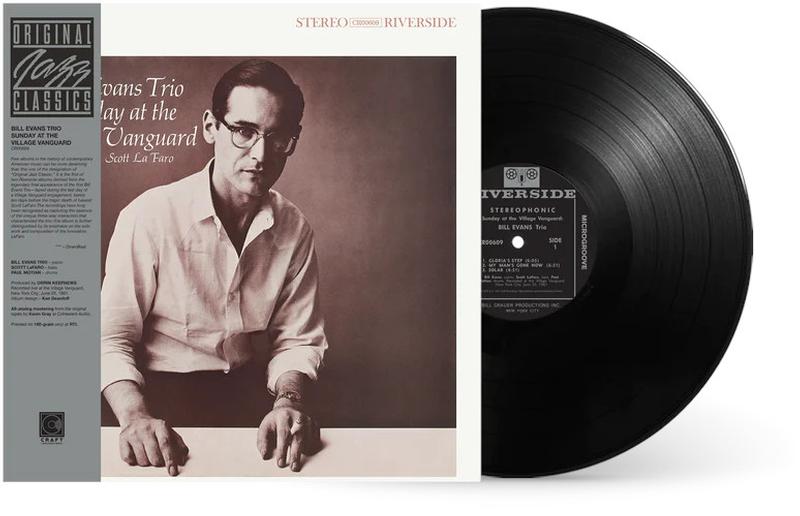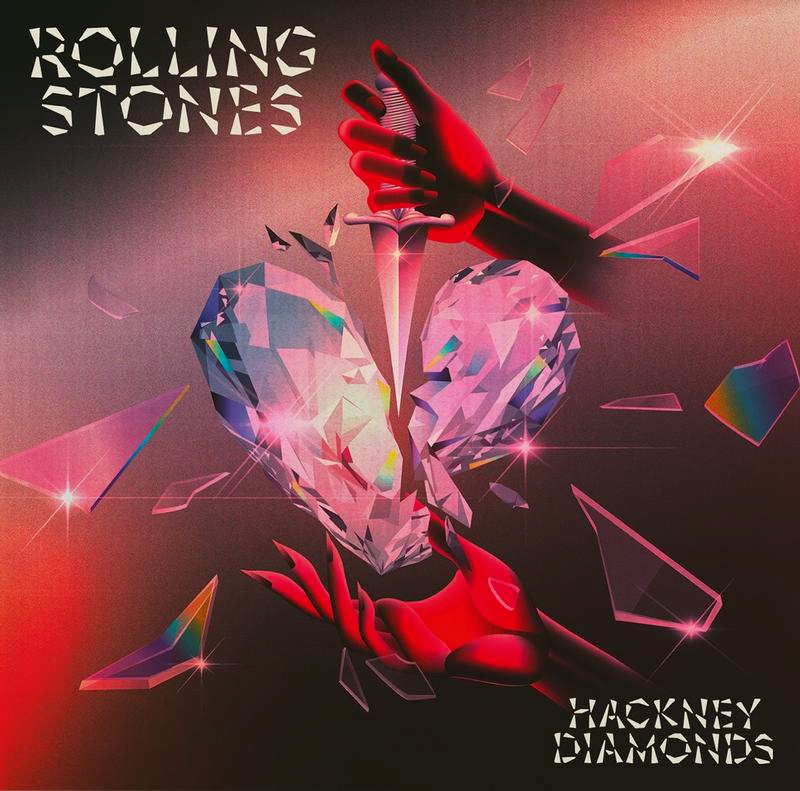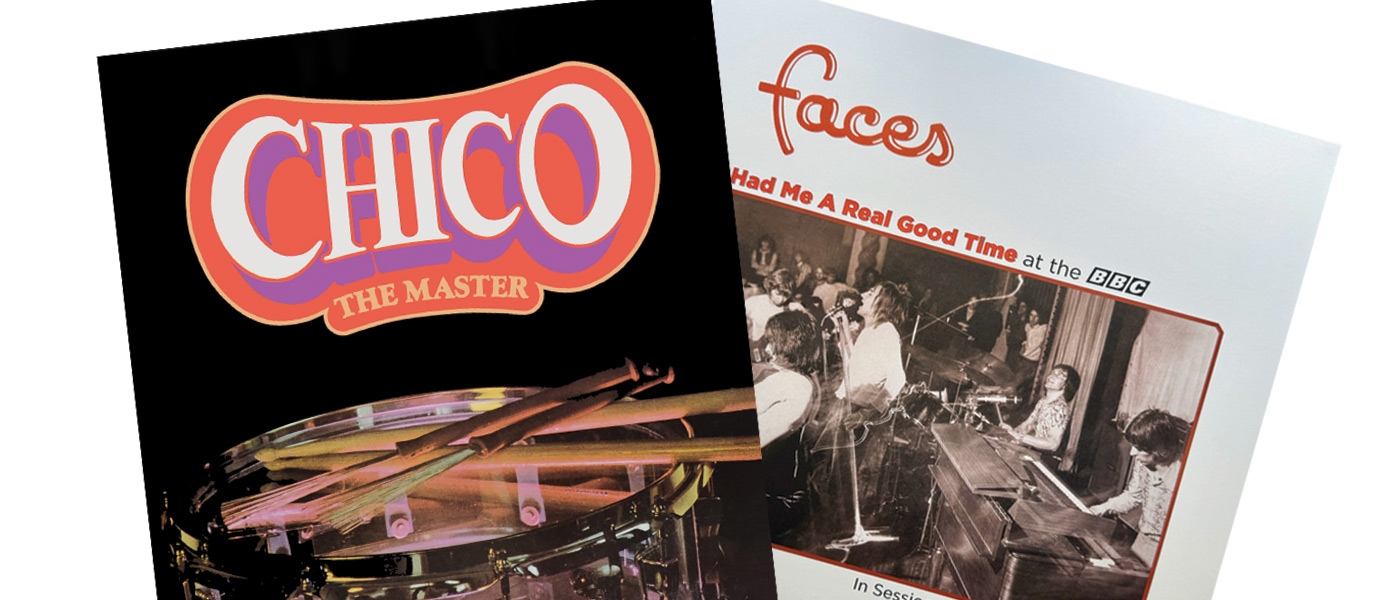
The playing is so fluid and the players so sensitive to each other’s contributions. The ambient clink of the occasional drink glass and the distant layer of audience noise seems to weave around the music in a way that frames it rather than distracts. Even La Faro’s off-mic bass solos, a feature of vintage Jazz recordings that often pulls me out of my listening reverie, works here. Paul Motian’s cymbal work is like a cleansing rain, and Evans comes up big for the single take recording date in June 1961. Like Bill Russell going for 30 points and 40 rebounds in Game Seven of the NBA Finals the following year.
Kevin Gray manned the boards for this reissue and cut the lacquers. “All-analog mastering from the original tapes” technically leaves a little wiggle room for some digitization in the chain, but I doubt it. Regardless, the clarity and balance is remarkable. This results in the opposite of listener’s fatigue. This begets listener’s rejuvenation. RTI’s pressing is flawless, and the record is blessedly flat. Not sure how much better the Analogue Productions take (by Gray and Steve Hoffman) could sound, although that one is cut at 45 RPM. I’d be thrilled to do a shootout between the two one day, but I’m not waiting around. I’ll be immersed in Craft’s work for a while.
Craft recently put out another piano album as part of the same series, which is worthy of consideration too, although wildly divergent from the Vanguard record. The Dave Brubeck Quartet’s Jazz At Oberlin is the “Atmospheric Sprite” to the Evans Trio’s “Adult In the Room.” Oberlin kicks off with a romp through “The Way You Look Tonight” featuring Paul Desmond’s alto sax work. Brubeck’s piano is forceful and percussive, especially during “How High The Moon.” It’s easy to picture him grinning madly while he works out on the keys. Hair wet, tie loose. Hell, he might have stood up, Jerry Lee Lewis-style. The liners suggest that Lloyd Davis manned the kit that night (March 2, 1953) with a 103-degree fever, and it sounds like the other players were about as hot. The recording itself is not quite on the level of what’s heard on Vanguard. It’s a bit further from the action, while the audience is more boisterous and assertive. Which seems at least a bit ironic as Oberlin was recorded in a chapel. The two records together make for a fascinating contrast, and perhaps an interesting study of how the musical tastes and styles might have evolved during the approximate eight years between the recordings. Or not. There’s room for both concurrently, and I’m certainly not aware of any competition between the two principals. Between the two, I’d utilize the Vanguard record as a palate cleanser. I’d use it to come down off the Brubeck high. Your mileage may vary for these two specific releases, but there’s no point in thinking that Craft Recordings is anything other than a major player in today’s bustling audiophile Jazz landscape. They’re consistently providing high-value returns with prices that are at least in line with, if not a bit below, market value. I trust their Original Jazz Classics and Small Batch series implicitly.

Continuing with the theme of Craft Recordings and their Jazz reissues…
They’ve released a historical document of a Clash of the Titans that happened in Toronto at Massey Hall during the Springtime of 1953. Charlie Parker, Dizzy Gillespie, Bud Powell, and Max Roach were commissioned to play a “Jazz Festival,” which seems to have occurred over the course of two whole sets of music. One by the artists listed above, the other by a Canadian Big Band that was hired to satisfy union demands in order for the show to be allowed to happen at all. And it was a “happening,” man. Way in advance of that term’s usage, but it applies in this instance. Fully.
Hot House: The Complete Jazz At Massey Hall Recordings is the documentation of an event that was fraught from the start. Sixty percent of the lineup’s members were notoriously troubled and often troublesome. Much of this can be chalked up to addiction, certainly in the cases of Parker and Powell. Charles Mingus was legendarily cantankerous, but that’s not a criticism. I think some historical context is in order. I don’t know much about societal conventions in 1953 Canada, but I’m sure Mingus had dealt with plenty of situations that might have resulted in what some would have considered “problematic” behaviors and beliefs. Being underpaid, not being allowed to eat in the same venues that one performed in, entering through the service entrance to avoid mingling with the patrons, and undoubtedly much worse… and then, being expected to smile and bow would cause any sentient being to react in whatever ways – conscious or otherwise – might serve as spiritual protection. So, yeah. Mingus had a hard time getting along with others. Go figure.
Secrets Sponsor
The liners, both informative and poignant, suggest that Mingus was raising hell with anyone available (including his performance partners) while Powell was barely functioning (his condition requiring the assistance of two caretakers), Parker was playing a plastic sax (after having pawned his primary instrument), and that Diz was more interested in a heavyweight championship happening concurrently in Chicago (that he kept up with via trips to the stage’s wings to consult a transistor radio) as Max Roach tried to bolt the whole thing to the floor so that it wouldn’t fly away. I’d have picked up on exactly none of this by listening.
When the players and stakeholders heard the final tapes, the bassist’s playing was entirely absent. A drunken sound tech had dropped the sonic ball. So Mingus swiped the tapes and may have had designs on erasing their contents altogether. This plot was somehow foiled, and Mingus overdubbed his parts in a studio later. Whew! I wish I’d not known that prior to listening, but I can’t mind my own business so I’d read all about it in advance. This is one of a few times I remember that I prefer the doctored version to the straight shot, and I think that would have been true if I’d gone in blind. The first disc in the three-record set contains the unadulterated version of the main programming while the third disc includes the same material but with the overdubs. The second record includes a drum solo from Roach that sounds like it was recorded from several cities away along with a trio performance featuring Powell, Roach, and Mingus. The playing is great, the recording sounds, at times, like it was made with a mic being held up to that transistor radio in the wings. There’s enough detail there to know that these cats were for real and that the sparsely attended show was historic.
Secrets Sponsor
And it’s all here for posterity. I’m thrilled to have access to it. I first became aware of Parker by reading Kerouac in early high school. I bought a cassette tape as soon as I could locate one and promptly drove my friends nuts with it for what seemed like years. It would be difficult to label any of Parker’s recordings as “audiophile,” at least the ones I’ve had the pleasure of hearing. The era’s technology was limiting. But Craft’s The Savoy 10-Inch LP Collection is a stone groove, and Hot House is too. Getting to hear Parker mix it up onstage with these other heavyweights is even more compelling than watching old tapes of Marciano’s fights. It’s fascinating to imagine that these bespectacled men in suits would have been considered as threatening to white audiences in 1953 as N.W.A. was with their words in 1993. Such was the power of Bop. And Hot House puts you right in the thick of it. Wrap your hands and keep your mouthpiece in. This one’s coming at you from all angles. Emotional, physical, intellectual, and spiritual. It’s an essential piece of Jazz history.
This is not a AAA release. The tapes have been doctored and restored. Kevin Gray cut the lacquers, the vinyl is quiet. I suspect the sound is superior to what one would have heard from a direct tape transfer. There’s still enough grit in the grooves to get a feel for the weight of this relic from a bygone era, but enough detail to experience the players’ collective genius. Not sure that it was “the greatest Jazz concert ever,” but it was a high water mark, and it’s still more than stimulating. As accessible to casual fans as it is to scholars. It’s an event on your shelf.

It’s simple: The Rolling Stones are my favorite Rock ’n’ Roll band. I found them early in my life, and I’ve kept them with me ever since. I was initially drawn in by the hits and was still in middle school when I started digging deeper. I was fully immersed in Exile On Main St. when I was 16 and I’m still wrestling with it during the penultimate year of my fifth decade. I love the music that the Rolling Stones have made very much, and it would be difficult to imagine my life without their songs as a soundtrack. I don’t even care to try.
I avoided hearing their latest, Hackney Diamonds until the work was available on vinyl. None other than Keith Richards endorsed it as the only way to hear the songs truthfully. I did see that zany video for “Angry” in advance of receiving my copy of Hackney. My appetite was stoked. I had my bathing suit on, and I was ready to get on the boat with the giant Tongue stenciled on its side…
…but it went right on by without me.
The hype was hard to avoid while heading towards the dock. People love this record, pretty much across the board. Perhaps I came in with expectations? Am I one of those fans who can’t let go of my ingrained viewpoint of what this assemblage of musicians “should” be or what they “should” produce? Man, I hope not. Intellectually, I realize that the artist should never be obligated to satisfy their audience’s expectations or desires. That’s really the only “should” I can get behind when it comes to Rock ’n’ Roll music.
I could have guessed that the production would be too shiny for my tastes. I mean, I did guess. I assumed that would be the case, and I was not mistaken. I was just hoping for a compelling batch of new Stones songs. I admit that I was mostly dreaming of some vintage grungy grooves. What I got was what sounded to me like an above-average Mick Jagger solo record. Not quite on par with Wandering Spirit, but not nearly as cringeworthy as She’s The Boss (God, forgive me for ever having typed those italicized words in that specific sequence).
Lots of the press around Hackney is specific to the guest spots. While Maca plays a ripping fuzz bass solo during “Bite My Head Off,” Gaga’s vocals on “Sweet Sounds of Heaven” are the only outsider contributions that really make an impact. That song’s strength shines a light on what this record could have been if the rest of the material were as formidable. There’s spontaneity and dynamics. Emotion and muscle. It’s a triumph. And it leads directly into Mick and Keith’s cover of Muddy’s “Rolling Stones Blues,” which closes the deal on a high note. By the time those songs end, I’m ready for Hackney Diamonds to begin. But that’s exactly where it ends.
The performances are energetic throughout, I’ll say that. The band sounds invigorated. I’m a little suspicious that the producer gets songwriting credit along with Jagger/Richards on three tunes. And that they’re all grouped together at the record’s outset. But mostly I just don’t really care for the way this album sounds or for the songs. It’s romantic to imagine that “Live By The Sword” would jump higher than the rest because of the contributions from Charlie Watts and Bill Wyman, but it gets washed out by the homogeneity surrounding it and within it. Just a lot of generic ‘90s Adult Contemporary Rock choruses and bland riffs. Sorry to have to say it. I truly am.
As for the vinyl itself, Keith was mistaken. GZ did a good job with the actual pressing, but the songs sound like they were designed to be heard through earbuds or Bluetooth speakers. The album lacks depth and dimensionality. Everything is sort of right out front, there’s not much to explore. It seems like the press just decided that it was time for the Stones to have another moment. Like when Jethro Tull won that Grammy over Metallica. And it sounds like they’ve got leftovers in the can that could still see the light of day. I’m not envisioning Tattoo You quality. I’m picturing myself reaching for 2016’s Blue and Lonesome when I want to hear modern Stones. Or, better yet, Keith’s Crosseyed Heart from the year before. I don’t begrudge anyone enjoying these warm, placid waters while celebrating the Stones. But I’m still looking for the rapids. This stuff is too safe.


